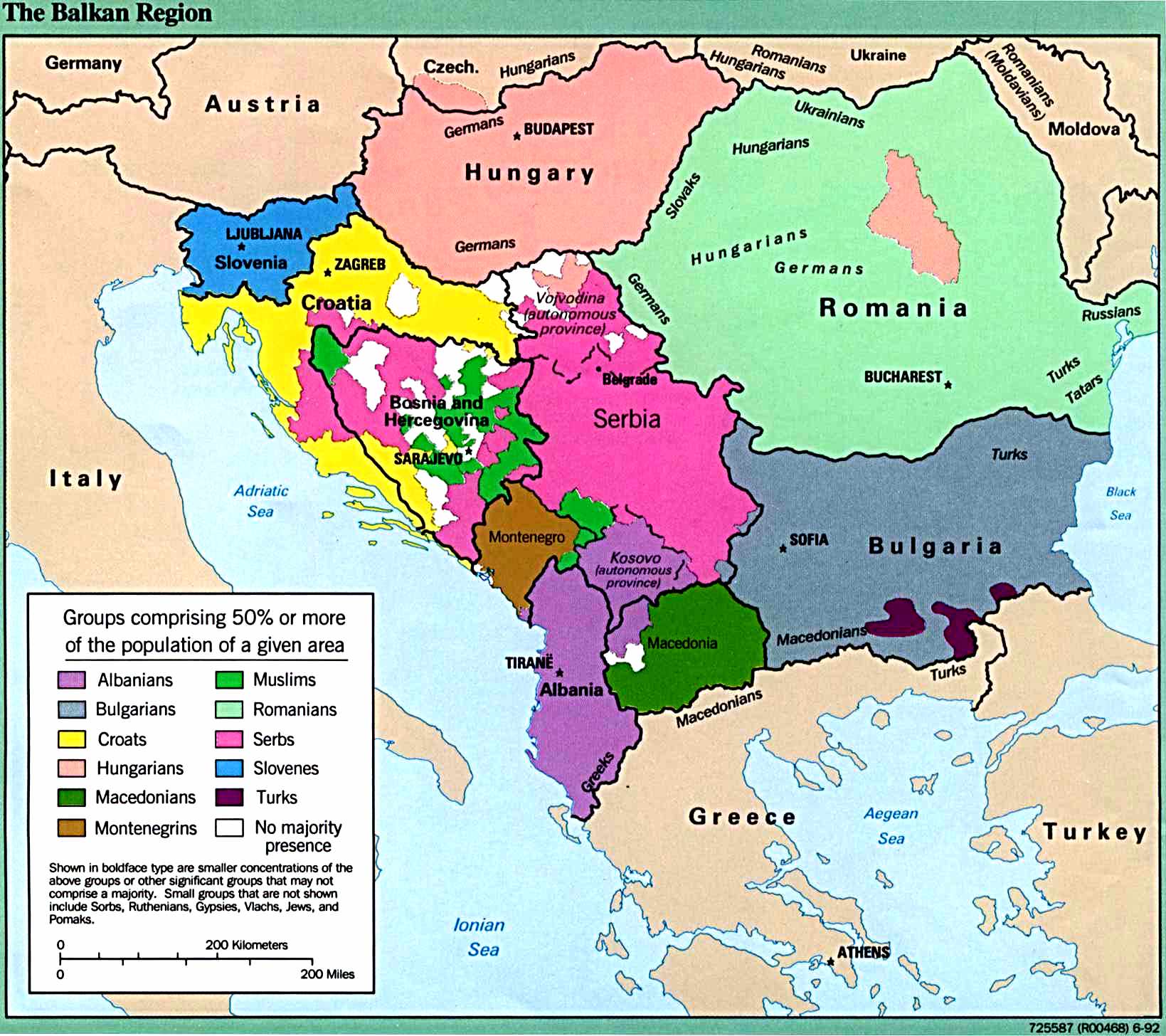The real judgment against Mladic, however, will be formed in the court of public opinion. And it is in this venue where indictments–usually hypocritical–and slogans–usually trite–function as “evidence”. It is here where language and imagery is used to conjure up the worst genocidal massacres in world history.
There is a craft at work here. For the audience to be effectively persuaded, emotion must take the place of reason. All discernment must be set aside. Only then will the stage be set to suggest how a tragedy like this can never happen again.
Bit by bit, we are seeing the fulfillment of one of Tony Blair’s great reforming visions. Ashamed, as so many were, by the sight of a Tory government standing by while one million people were slaughtered in a genocide in Rwanda, and European citizens were ethnically cleansed in former Yugoslavia, Blair developed a doctrine of “liberal interventionism”. Set out in principle in his Chicago speech and in practice in Sierra Leone, Afghanistan, Kosovo and Iraq.
I had feared that the public unpopularity of the Iraq War would lead the current generation of politicians to back off from muscular intervention. I’m glad to say I was wrong, and both David Cameron and Ed Miliband were swift and strong to urge and back intervention in Libya. This is the first UN sanctioned action under the doctrine of Responsibility to Protect, itself Blairism in action.
For Colonel Gaddafi’s Libyan regime, the significance of today’s arrest is enormous. Gaddafi must clearly see that he will be brought to justice. And he is very unlikely to have as long as fifteen years on the run – it’s harder now to hide than it was in the 1990s. Now, more than ever, he should be looking for a negotiated end to the Libyan conflict. [1]
“I had worked in Sarajevo, where Serb snipers took target practice on bundled old ladies hauling canisters of filthy water across town and where picturesque parks had been transformed into cemeteries to accommodate the deluge of young arrivals. I had interviewed emaciated men who had dropped forty and fifty pounds and who bore permanent scars from their time in Serb concentration camps…. [And yet] it never dawned on me that General Mladic would or could systematically execute every last Muslim man and boy in his custody.” [2]
[Power] described herself as “haunted” by both her “own failure to sound a proper early warning, and the outside world’s refusal to intervene even once the men’s peril had become obvious.” [3]
CHARLIE ROSE: Where are we in this idea of when it is that nations are prepared to invade another nation`s sovereignty because of crimes against humanity taking place?
MADELEINE ALBRIGHT: Charlie, I think that we have learned a lot of lessons about this and, in fact, you know, people make arguments — I would not be one of them — that we did not know what was going on during World War II.
There is a new doctrine that has come out as a result of more knowledge that`s called responsibility to protect. And partially the United Nations resolution on Libya is based on the idea that if the international community knows about horrors that are taking place that we have a common responsibility to [do] something about it. And NATO, frankly, is one of the very good instruments for having it take place.
It does bump up against sovereignty. It is one of the difficult aspects of this. But I think that we have acted rightly in Libya.
And the other part that is a lesson out of this that those who are responsible for murdering their people or ordering that they be murdered ultimately justice does catch up with them. It has happened with Osama bin Laden. It has happened now with Ratko Mladic and Karadzic and Milosevic and ultimately it is my belief it will catch up with those responsible for Libya — Gadhafi. And there is a movement in the prosecutor for the international criminal court has been interested in making sure that Gadhafi is labeled as somebody who has committed crimes against humanity. And the United Nations resolution is based on this responsibility that we have to each other. [4]
 The reason “responsibility to protect” is so effective as a strategy doctrine is that it justifies the most irresponsible and criminal actions of the globalist community by conjuring up unthinkable horrors to a susceptible public; a pogrom of bloodshed and evil which the mind shudders to comprehend. What can the reader of these horror stories know of actual genocide, ethnic cleansing, or mass murder? What can any of us know of the mind of the man that has been deemed responsible for these crimes? The mind seems to recoil from any attempt to understand, replaced instead by a powerful need to stop these atrocities at any cost. This is the value of such a doctrine; this is why it is now used. It is fear; propelled forward by an anxious desire to stop the impending bloodshed. Just think: when a bloodbath is upon us, is there time to debate the differing interpretations of the events in question? There is no time to wait for a more thorough investigation; no time to argue about whether the story is right or wrong; or about whether our supposedly outdated legal concepts need to be bent or broken. There is only the feverish rush to stop the massacre, bolstered by the need to punish the monster that will commit it. We must take action. And we cannot wait.
The reason “responsibility to protect” is so effective as a strategy doctrine is that it justifies the most irresponsible and criminal actions of the globalist community by conjuring up unthinkable horrors to a susceptible public; a pogrom of bloodshed and evil which the mind shudders to comprehend. What can the reader of these horror stories know of actual genocide, ethnic cleansing, or mass murder? What can any of us know of the mind of the man that has been deemed responsible for these crimes? The mind seems to recoil from any attempt to understand, replaced instead by a powerful need to stop these atrocities at any cost. This is the value of such a doctrine; this is why it is now used. It is fear; propelled forward by an anxious desire to stop the impending bloodshed. Just think: when a bloodbath is upon us, is there time to debate the differing interpretations of the events in question? There is no time to wait for a more thorough investigation; no time to argue about whether the story is right or wrong; or about whether our supposedly outdated legal concepts need to be bent or broken. There is only the feverish rush to stop the massacre, bolstered by the need to punish the monster that will commit it. We must take action. And we cannot wait.  You better believe you’re being lied to. This is the Bosnian “concentration camp” image that sold the war to the world–a monstrous lie.
You better believe you’re being lied to. This is the Bosnian “concentration camp” image that sold the war to the world–a monstrous lie.
Please watch this three-part documentary to learn the truth behind the image; find out exactly how it was done.
Yasushi Akashi, former UN Representative in Bosnia, admitted in the Washington Times of 1 November 1995, that “it is a fact that the Bosnian government forces have used the ‘safe areas’ of not only Srebrenica, but Sarajevo, Tuzla, Bihac, Gorazde for training, recuperation and refurbishing their troops.” In other words, the so-called safe areas were used as military posts to train Mujahedin fighters from Afghanistan, Iran, Syria, Turkey and the entire Islamic world, free to commit their treachery by attacking Serbian villages and returning like thieves in the night back to the safety of their UN protectors who conveniently looked the other way to these violations. Prior to the events at Srebrenica, these “Holy Warriors of Islam” had attacked 42 surrounding Serbian villages and over 3,000 Serbian villagers had been slaughtered without fear of being reprimanded or punished by the UN. Yet, when Serbs were provoked to retaliate against these Muslim assaults from these so-called “safe-areas,” they were condemned by the entire world.
Further proof of the violations of proclaimed “safe areas” by Bosnian Muslim forces was provided by Lt. Gen. Sir Michael Rose, former UNPROFOR commander who stated that Muslims “shoot on the Serbs to step up the pressure and to obtain a fresh intervention from NATO.” [5]
From the U.N. Secretary General’s 1999 Report on Srebrenica, it emerges that the idea of a “Srebrenica massacre” was already in the air at a September 1993 meeting in Sarajevo between Bosnian Muslim president Alija Izetbegovic and members of his Muslim party from Srebrenica. On the agenda was a Serb proposal to exchange Srebrenica and Zepa for some territories around Sarajevo as part of a peace settlement.
“The delegation opposed the idea, and the subject was not discussed further. Some surviving members of the Srebrenica delegation have stated that President Izetbegovic also told them he had learned that a NATO intervention in Bosnia and Herzegovina was possible, but could only occur if the Serbs were to break into Srebrenica, killing at least 5,000 of its people.”
Izetbegovic later denied this, but he is outnumbered by witnesses. It is clear that Izetbegovic’s constant strategy was to portray his Muslim side in the bloody civil war as pure helpless victims, in order to bring U.S. military power in on his side. On his death bed, he readily admitted as much to his ardent admirer Bernard Kouchner, in the presence of U.S. diplomat Richard Holbrooke. Kouchner reminded Izetbegovic of a conversation he had had with French President Mitterrand in which he “spoke of the existence of ‘extermination camps’ in Bosnia.”
Kutchner: ‘You repeated that in front of the journalists. That provoked considerable emotion throughout the world. […] They were horrible places, but people were not systematically exterminated. Did you know that?
Izetbegovich: Yes. I thought that my revelations could precipitate bombings. I saw the reaction of the French and the others-I was mistaken. […] Yes, I tried, but the assertion was false. There were no extermination camps whatever the horror of those places. [6]
In testimony to a French parliamentary commission inquiry into Srebrenica, General Philippe Morillon, the UNPROFOR officer who first called international attention to the Srebrenica enclave, stated his belief that Bosnian Serb forces had fallen into a “trap” when they decided to capture Srebrenica.
Subsequently, on February 12, 2004, testifying at the International Criminal Tribunal in The Hague, General Morillon stressed that the Muslim commander in Srebrenica, Naser Oric, “engaged in attacks during Orthodox holidays and destroyed villages, massacring all the inhabitants. This created a degree of hatred that was quite extraordinary in the region, and this prompted the region of Bratunac in particular—that is the entire Serb population—to rebel against the very idea that through humanitarian aid one might help the population that was present there.”
Asked by the ICTY prosecutor how Oric treated his Serb prisoners, General Morillon, who knew him well, replied that “Naser Oric was a warlord who reigned by terror in his area and over the population itself. I think that he realized that these were the rules of this horrific war, that he could not allow himself to take prisoners. According to my recollection, he didn’t even look for an excuse. It was simply a statement: One can’t be bothered with prisoners.” [7]
…the Muslim high command in Sarajevo ordered the Srebrenica commanders, Oric and his lieutenants, to withdraw from Srebrenica, leaving thousands of his soldiers without commanders, without orders, and in total confusion when the foreseeable Serb attack occurred. Surviving Srebrenica Muslim officials have bitterly accused the Izetbegovic government of deliberately sacrificing them to the interests of his State. [8]
 What is undisputed in all accounts is that Bosnian Serb forces overtook the town. The question that remains debated–and that which is of central importance today–is whether a “genocidal massacre” of the Muslim population can be said to have occurred. Then-U.S. Ambassador to the United Nations, Madeleine Albright, “proved” her case of genocide by waving satellite photos of discolored dirt mounds, claiming they were mass graves. In her recent interview with Charlie Rose, Albright stated, “…the thing I did was to get declassified the photographs of what was going on in Srebrenica. We had pictures that showed [what] had been an empty field, then a field with people, then a field with rats as the people disappeared. And I took that to the Security Council and I think it opened the way for us then ultimately to take action.” [9]
What is undisputed in all accounts is that Bosnian Serb forces overtook the town. The question that remains debated–and that which is of central importance today–is whether a “genocidal massacre” of the Muslim population can be said to have occurred. Then-U.S. Ambassador to the United Nations, Madeleine Albright, “proved” her case of genocide by waving satellite photos of discolored dirt mounds, claiming they were mass graves. In her recent interview with Charlie Rose, Albright stated, “…the thing I did was to get declassified the photographs of what was going on in Srebrenica. We had pictures that showed [what] had been an empty field, then a field with people, then a field with rats as the people disappeared. And I took that to the Security Council and I think it opened the way for us then ultimately to take action.” [9]Tim Butcher of the Daily Telegraph, London (24 July 1995), wrote regarding Srebrenica, “After five days of interviews the United Nations chief investigator into alleged human rights abuses during the fall of Srebrenica has not found any firsthand witnesses of atrocities.”
An International Committee of the Red Cross (ICRC) report, document #37, dated September 13, 1995 states: “Approximately 5,000 Srebrenica Muslim troops left the enclave prior to its fall. The Muslim government has admitted that these men were reassigned to other units of its armed forces. The fact that family members were not informed of it was justified by the obligation to keep it a military secret.” The ICRC further reported that there were indications that sporadic clashes broke out between the Muslim soldiers who wanted to stay and fight and other soldiers and civilians who wanted to flee. In some cases, the names of “missing” soldiers are listed as many as two and three times. As previously stated, approximately fewer than 2,000 bodies have been found in graves. Considering that the civil war in Bosnia had lasted over four years, this could not exactly be called a “genocide” when compared to other massacres taking place all over the world such as in Sierra Leone, Rwanda, Zimbabwe, and Indonesia. [10]
“Everybody is parroting everybody [about Srebrenica] but nobody shows hard evidence. In the Netherlands people want to prove at all costs that genocide has been committed. I don’t believe any of it. The day after the collapse of Srebrenica, July 13, I arrived in Bratunac [alleged massacre site] and stayed there for eight days. I was able to go wherever I wanted to. I was granted all possible assistance; nowhere was I stopped.” [11]
We will now address the case behind the so-called atrocities in Libya. According to one UN commentator, the international military bombardment of Libya is the world’s first experiment in “responsibility to protect” In other words, the legal norms justifying attacks upon nation-states are now being redefined with Libya as the test case. Regardless of what one thinks about the R2P doctrine in the abstract, it would certainly help to know if the claims being made against the Gaddafi government are legitimate or another pack of lies.
Q: Do you see any evidence that [Gaddafi] actually has fired on his own people from the air? There were reports of it, but do you have independent confirmation? If so, to what extent?
SEC. GATES: We’ve seen the press reports, but we have no confirmation of that.
ADM. MULLEN: That’s correct. We’ve seen no confirmation whatsoever.
Q: Mr. Secretary, could you give us your assessment of the situation on the ground? How bad is it? Can the rebels take Tripoli? Are thousands dying?
SEC. GATES: Well, the — I think the honest answer, David, is that we don’t know in that respect, in terms of the number of casualties. In terms of the potential capabilities of the opposition, we’re in the same realm of speculation, pretty much, as everybody else. I haven’t seen anything that would give us a better read on the number of rebels that have been killed than you have. And I think it remains to be seen how effectively military leaders who have defected from Gaddhafi’s forces can organize the opposition in the country. And we are watching that unfold, as you are. [12]
Concluding Thoughts
This administration has now been organized about a Central Council for World Affairs…It is the only sovereign upon this planet. There is now no other primary authority from end to end of the earth. All other sovereignty and all proprietary rights whatever that do not conduce directly to the general welfare of mankind ceased to exist during the period of disorder, and cannot be revived. [15] H.G. Wells, The Shape of Things to Come (1933)
In recent weeks, it has often been stated by members of the media that the president does, in fact, have the legal authorization to wage war without congressional approval. The argument implies that, in these circumstances, the president must gain congressional approval for this war within sixty days of the beginning of the conflict. If no approval has been granted, these people say, the president must then cease military operations within another thirty days.
The above argument is founded upon the War Powers Resolution, passed by congress in 1973. In the legislation, “sixty days” of unilateral presidential war powers are granted only if specific conditions are met. The document states: “The constitutional powers of the President as Commander-in-Chief to introduce United States Armed Forces into hostilities, or into situations where imminent involvement in hostilities is clearly indicated by the circumstances, are exercised only pursuant to (1) a declaration of war, (2) specific statutory authorization, or (3) a national emergency created by attack upon the United States, its territories or possessions, or its armed forces.”[17]
The NATO operation in Libya does not meet any of these three stipulations, and yet the media states this lie authoritatively as if it were truth. And by repeating the lie, in many ways it has become truth. The public has been trained to wait for the president to uphold his legal responsibility, his fictitious “sixty day” responsibility. But in fact his legal responsibility was violated the moment the operation began. He has been breaking the law all along. There was no congressional declaration of war; no specific statutory authorization had been given; no “national emergency” had been declared. The president sent this nation to war, and he did so without even the slightest attempt to placate his constitutional obligation to congress; the legal checks upon his power; or his responsibility to the American citizenry.
And what of those “sixty days”? Since this lie has suddenly become de facto law, it would seem that the sixty day time frame has a modicum of importance. What day are we on? Where are we now?
Last Wednesday, the 25th of May, was day sixty…the clock was running out. Oh, what to do! How about a monumental PR stunt? How about nabbing a genocide-committing villain–a “butcher”? Like Ratko Mladic! Call President Tadic in Belgrade! We can drag Mladic out before the American public! And the rest of the world!
Thursday, the 26th of May, day sixty-one: the news of Ratko Mladic’s arrest took us by surprise.
Endnotes:
[1] McTernan, John “The Arrest of Ratko Mladic Tells Muammar Gaddafi — You Can Run But You Can’t Hide”, (Telegraph), May 26, 2011. See also, Tony Blair, “Doctrine of the International Community at the Economic Club,” April 24, 1999.
[2] Power, Samantha, A Problem From Hell: America in the Age of Genocide (Harper Perennial).
[3] Ackerman, Spencer, “Mastermind of Bosnia Massacre Caught, 16 Years Later” (Wired), May 26, 2011.
[4] The Charlie Rose Show (Bloomberg TV), May 26, 2011.
[5] Jatras, Stella L., “‘Srebrenica’ — Code Word to Silence Critics of U.S. Policy in the Balkans,” (Antiwar.com), July 31, 2000
[6] Johnstone, Diana, “Srebrenica Revisited: Using War as an Excuse for More War,” (Counterpunch), October 12, 2005.
[7] Ibid.
[8] Ibid.
[9] The Charlie Rose Show (Bloomberg TV), May 26, 2011.
[10] Jatras, Stella L. “Srebrenica’ — Code Word to Silence Critics of U.S. Policy in the Balkans,” (Antiwar.com), July 31, 2000
[11] Israel, Jared, “Srebrenica, A Small Town in Yugoslavia: Five Years On and the Lies Continue,” July 29, 2000.
[12] D.O.D. News Briefing With Secretary Gates and Adm. Mullen From the Pentagon, March 1, 2011.
[13] Escobar, Pepe, “Endgame: Divide, Rule and Get the Oil (Asia Times Online), March 25, 2011.
[14] Tarpley, Webster, “The CIA’s Libyan Rebels: The Same Terrorists Who Killed U.S., NATO Troops in Iraq” (tarpley.net), March 24, 2011.
[15] The Constitution of the United States, Article 1, Section 8
[16] War Powers Resolution of 1973 (50 U.S.C. 1541-1548)










